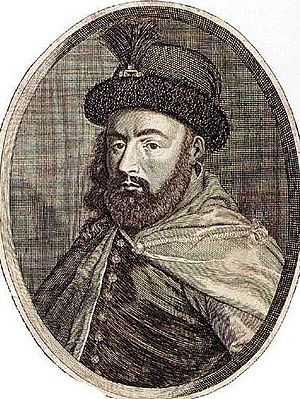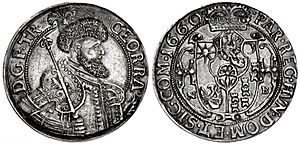George II Rákóczi facts for kids
Quick facts for kids George II Rákóczi |
|||||
|---|---|---|---|---|---|

George II Rákóczi
|
|||||
| Prince of Transylvania | |||||
| Reign | 11 October 1648 – 7 June 1660 | ||||
| Predecessor | George I Rákóczi | ||||
| Successor | John Kemény | ||||
| Born | 30 January 1621 Sárospatak, Hungary |
||||
| Died | 7 June 1660 (aged 39) Nagyvárad, Principality of Transylvania |
||||
| Spouse |
Sophia Báthory
(m. 1643; died 1660) |
||||
| Issue |
|
||||
|
|||||
| House | Rákóczi | ||||
| Father | George I Rákóczi | ||||
| Mother | Zsuzsanna Lorántffy | ||||
| Religion | Calvinism | ||||
George II Rákóczi (born January 30, 1621 – died June 7, 1660) was an important Hungarian nobleman. He served as the Prince of Transylvania from 1648 to 1660. He was the oldest son of George I Rákóczi and Zsuzsanna Lorántffy.
Contents
Early Life and Family
George II Rákóczi was chosen to be the Prince of Transylvania while his father was still alive. This happened on February 19, 1642.
On February 3, 1643, he married Sophia Báthory. She was the granddaughter of a famous leader named Stephen Báthory IX. George and Sophia had a son named Francis I Rákóczi.
Ambitions and Wars
When George II Rákóczi became prince in October 1648, he had big plans. He wanted to achieve his father's goals in Poland.
Planning for Conflict
To reach his goals, George II Rákóczi made alliances. In early 1649, he teamed up with Bohdan Khmelnytsky, a leader of the Cossacks. He also allied with the rulers of Moldavia and Wallachia. These rulers were Vasile Lupu and Matei Basarab.
For several years, he didn't take any action. Then, on December 6, 1656, he signed a deal called the Treaty of Radnot. This treaty formed an alliance with King Charles X Gustav of Sweden. They planned to fight against King John II Casimir of Poland. Rákóczi hoped to take over parts of Poland, including Lesser Poland and Mazovia. He also wanted control of rich salt mines in Wieliczka and Bochnia.
Invading Poland
In 1657, George II Rákóczi launched an invasion. His target was the Polish–Lithuanian Commonwealth. This conflict was part of a larger war known as the Second Northern War (1655–1660), or "the Deluge."
The March Begins
In late January 1657, Rákóczi's army, which had about 25,000 soldiers, crossed the Carpathian Mountains. They marched near a town called Krosno. The Transylvanian army headed towards Medyka. There, 10,000 Zaporozhian Cossacks joined them. These Cossacks were led by Anton Zdanovich.
The combined army approached Lwów but could not capture the strong city. Then, they moved west towards Kraków. As they marched, the army caused a lot of destruction. They looted towns and destroyed places like Dukla, Lesko, and Sanok. However, they failed to take Przemyśl, Krosno, and Łańcut. On March 21, 1657, Rákóczi entered Tarnów. Seven days later, he reached Kraków, which was already controlled by the Swedes.
Joining Forces
The Swedish soldiers in Kraków received help. About 2,500 Transylvanian soldiers, led by János Bethlen, joined them. The rest of Rákóczi's army moved north. On April 12, near Ćmielów, the Transylvanians met the Swedish army. This Swedish army was led by King Charles X Gustav.
The combined forces crossed the Vistula River at Zawichost. On April 19, they captured Lublin.
Capturing Cities
On May 8, the Swedish-Transylvanian army started to surround Brest Litovsk. They captured it two days later. After this victory, Rákóczi's soldiers plundered and looted many areas. They burned towns like Biała Podlaska and Brańsk to the ground.
On May 20, King Charles X Gustav received news about another war. This was the Dano-Swedish War. The king decided to leave and march towards Swedish Pomerania. He left Gustaf Otto Stenbock in charge of the army.
The army then marched towards Warsaw. They burned towns like Mielnik, Drohiczyn, Nur, Brok, and Pniewo. On June 17, after three days of fighting, Rákóczi and Stenbock captured Warsaw.
The Swedish forces stayed in Warsaw for only a few days. On June 22, they left the city to join the war against Denmark. Rákóczi knew his army was not strong enough to hold Warsaw alone. So, he decided to leave Warsaw too and head southeast.
Retreat and Defeat
The Polish King, John II Casimir Vasa, ordered his forces to follow the Transylvanians. A 10,000-strong army, led by Stefan Czarniecki, chased them. They were supported by Lithuanian and Austrian allies. At the same time, Jerzy Lubomirski's forces invaded Transylvania. They looted and destroyed Rákóczi's lands.
On July 8, 1657, in Lancut, Polish leaders decided to split their forces. Stefan Czarniecki continued to follow Rákóczi. Jerzy Lubomirski and Stanisław "Rewera" Potocki tried to stop the Transylvanians and Cossacks from escaping Poland.
On July 11, Czarniecki partly destroyed the Transylvanian army in the Battle of Magierów. On July 16, the Polish armies joined together. On July 20, Rákóczi was defeated in the Battle of Czarny Ostrów.

Rákóczi Gives Up
After his defeat, Rákóczi's Cossack allies retreated. Rákóczi himself pulled back towards the town of Miedzyboz. There, he surrendered to Jerzy Lubomirski on July 23. He promised to end his alliance with Sweden. He also agreed to give up the cities of Kraków and Brest Litovsk. Finally, he had to pay a large sum of money, over 4 million złotys.
Final Blow by the Tatars
Polish commanders allowed Rákóczi's remaining forces to march towards Transylvania. However, on July 26, Rákóczi was attacked by the Crimean Tatars. At that time, the Tatars were allies of Poland–Lithuania. Rákóczi left his army and put János Kemény in charge.
The Transylvanian camp, near Trembowla, was captured by the Tatars on July 31. About 500 soldiers were killed. Around 11,000 Transylvanians were captured and taken to Crimea. Because of this, Rákóczi's army was completely destroyed.
Losing and Regaining Power
On November 3, 1657, the Ottoman Empire ordered a change. Transylvania had to pay taxes to the Ottomans. The Transylvanian assembly, called the Diet, removed Rákóczi from power. They did this because he started a war without their permission. Francis Rhédey took his place.
But in January 1658, a new meeting of the Diet brought Rákóczi back. He was again removed by the Turkish Grand Vizier, a high official. Yet, he was reinstated as if nothing had happened.
War with the Ottomans
Eventually, the Turks invaded Transylvania. Rákóczi died in Nagyvárad from injuries he received at the battle of Gilău in May 1660.
| Preceded by George I Rákóczi |
Prince of Transylvania 1648– Nov.1657 |
Succeeded by Francis Rhédey |
| Preceded by Francis Rhédey |
Prince of Transylvania Jan.1658–Sep.1658 |
Succeeded by Ákos Barcsay |
| Preceded by Ákos Barcsay |
Prince of Transylvania Aug.1659–Jun.1660 |
Succeeded by Ákos Barcsay |

